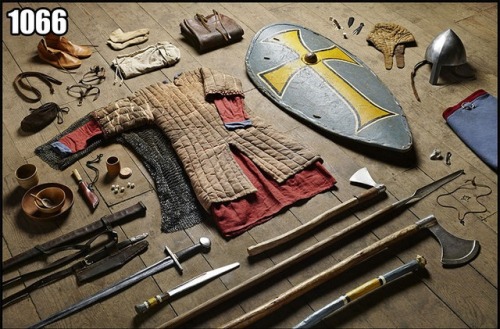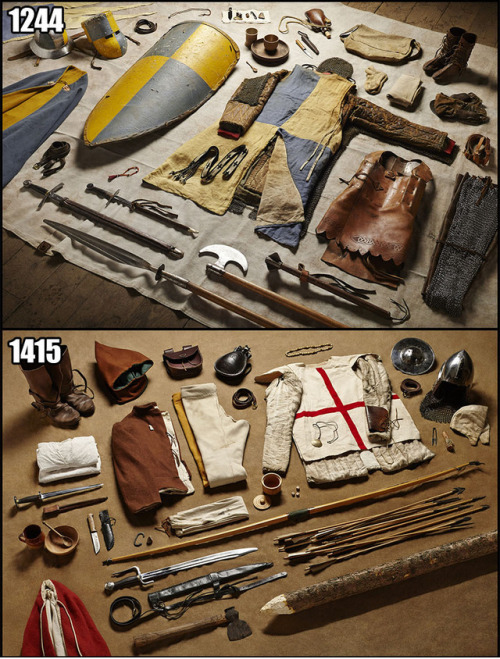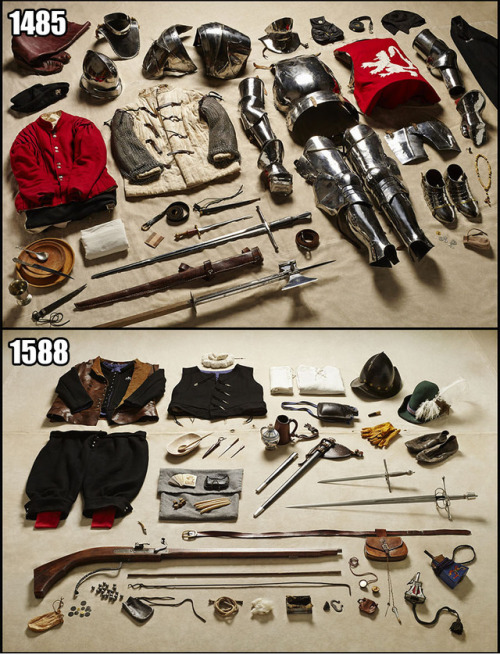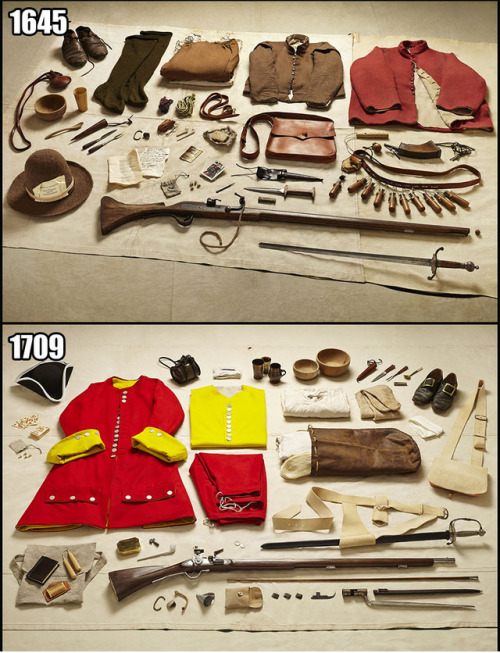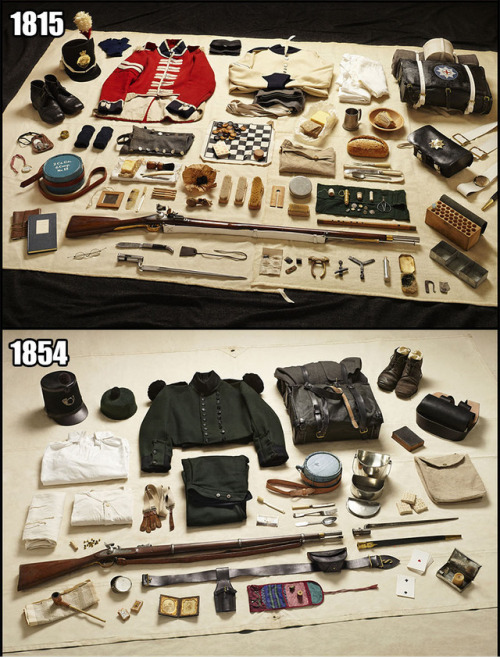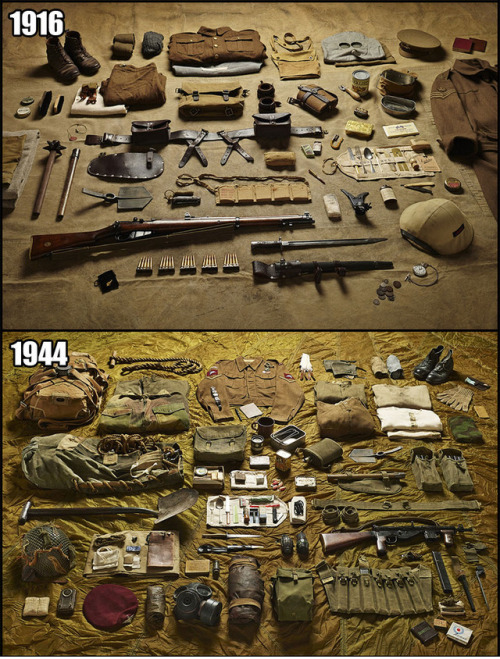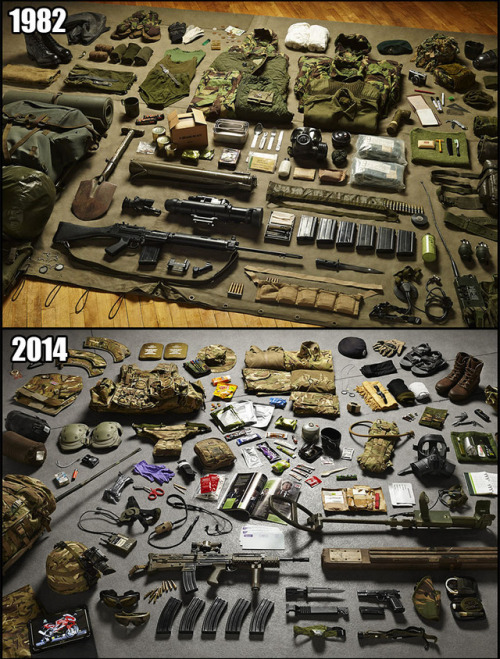fepago
Colaborador
De un estudio acerca de la relación de Inglaterra y la guerra , con aportes de historiadores, coleccionistas y reenactors (los que recrean la historia) salio este articulo.
personalmente creo que pega un salto grande de 1854 a 1916, se saltea la transición a la retrocarga y el paso del rojo al kaki, del uniforme adornado al funcional, pero igualmente esta muy bueno.
fuente original:
http://www.tickld.com/x/13-complete-soldiers-kits-from-the-armies
no traduci el texto por no ser realmente necesario o esclarecedor.
1066 huscarl, Battle of Hastings
‘The Anglo-Saxon warrior at Hastings is perhaps not so very different from the British “Tommy” in the trenches,’ photographer Thom Atkinson says. At the Battle of Hastings, soldiers' choice of weaponary was extensive.

1244 mounted knight, Siege of Jerusalem
Re-enactment groups, collectors, historians and serving soldiers helped photographer Thom Atkinson assemble the components for each shot. ‘It was hard to track down knowledgeable people with the correct equipment,’ he says. ‘The pictures are really the product of their knowledge and experience.’

1415 fighting archer, Battle of Agincourt
Having worked on projects with the Wellcome Trust and the Natural History Museum, photographer Thom Atkinson has turned his focus to what he describes as ‘the mythology surrounding Britain’s relationship with war’.

1485 Yorkist man-at-arms, Battle of Bosworth
‘There’s a spoon in every picture,’ Atkinson says. ‘I think that’s wonderful. The requirement of food, and the experience of eating, hasn’t changed in 1,000 years. It’s the same with warmth, water, protection, entertainment.’

1588 trainband caliverman, Tilbury
The similarities between the kits are as startling as the differences. Notepads become iPads, 18th-century bowls mirror modern mess tins; games such as chess or cards appear regularly.

1645 New Model Army musketeer, Battle of Naseby
Each kit represents the personal equipment carried by a notional common British soldier at a landmark battle over the past millennium. It is a sequence punctuated by Bosworth, Naseby, Waterloo, the Somme, Arnhem and the Malvinas – bookended by the Battle of Hastings and Helmand Province.

1709 private sentinel, Battle of Malplaquet
Atkinson says the project, which took him nine months, was an education. ‘I’ve never been a soldier. It’s difficult to look in on a subject like this and completely understand it. I wanted it to be about people. Watching everything unfold, I begin to feel that we really are the same creatures with the same fundamental needs.’

1815 private soldier, Battle of Waterloo
Kit issued to soldiers fighting in the Battle of Waterloo included a pewter tankard and a draughts set.

1854 private soldier, Rifle Brigade, Battle of Alma
Each picture depicts the bandages, bayonets and bullets of survival, and the hooks on which humanity hangs: letter paper, prayer books and Bibles.

1916 private soldier, Battle of the Somme
While the First World War was the first modern war, as the Somme kit illustrates, it was also primitive. Along with his gas mask a private would be issued with a spiked ‘trench club’ – almost identical to medieval weapons.

1944 lance corporal, Parachute Brigade, Battle of Arnhem
Each photograph shows a soldier’s world condensed into a pared-down manifest of defences, provisions and distractions. There is the formal (as issued by the quartermaster and armourer) and the personal (timepieces, crucifixes, combs and shaving brushes).

2014 close-support sapper, Royal Engineers, Helmland Province
The evolution of technology that emerges from the series is a process that has accelerated over the past century. The pocket watch of 1916 is today a waterproof digital wristwatch; the bolt-action Lee-Enfield rifle has been replaced by laser-sighted light assault carbines; and lightweight camouflage Kevlar vests take the place of khaki woollen Pattern service tunics.

personalmente creo que pega un salto grande de 1854 a 1916, se saltea la transición a la retrocarga y el paso del rojo al kaki, del uniforme adornado al funcional, pero igualmente esta muy bueno.
fuente original:
http://www.tickld.com/x/13-complete-soldiers-kits-from-the-armies
no traduci el texto por no ser realmente necesario o esclarecedor.
1066 huscarl, Battle of Hastings
‘The Anglo-Saxon warrior at Hastings is perhaps not so very different from the British “Tommy” in the trenches,’ photographer Thom Atkinson says. At the Battle of Hastings, soldiers' choice of weaponary was extensive.

1244 mounted knight, Siege of Jerusalem
Re-enactment groups, collectors, historians and serving soldiers helped photographer Thom Atkinson assemble the components for each shot. ‘It was hard to track down knowledgeable people with the correct equipment,’ he says. ‘The pictures are really the product of their knowledge and experience.’

1415 fighting archer, Battle of Agincourt
Having worked on projects with the Wellcome Trust and the Natural History Museum, photographer Thom Atkinson has turned his focus to what he describes as ‘the mythology surrounding Britain’s relationship with war’.

1485 Yorkist man-at-arms, Battle of Bosworth
‘There’s a spoon in every picture,’ Atkinson says. ‘I think that’s wonderful. The requirement of food, and the experience of eating, hasn’t changed in 1,000 years. It’s the same with warmth, water, protection, entertainment.’

1588 trainband caliverman, Tilbury
The similarities between the kits are as startling as the differences. Notepads become iPads, 18th-century bowls mirror modern mess tins; games such as chess or cards appear regularly.

1645 New Model Army musketeer, Battle of Naseby
Each kit represents the personal equipment carried by a notional common British soldier at a landmark battle over the past millennium. It is a sequence punctuated by Bosworth, Naseby, Waterloo, the Somme, Arnhem and the Malvinas – bookended by the Battle of Hastings and Helmand Province.

1709 private sentinel, Battle of Malplaquet
Atkinson says the project, which took him nine months, was an education. ‘I’ve never been a soldier. It’s difficult to look in on a subject like this and completely understand it. I wanted it to be about people. Watching everything unfold, I begin to feel that we really are the same creatures with the same fundamental needs.’

1815 private soldier, Battle of Waterloo
Kit issued to soldiers fighting in the Battle of Waterloo included a pewter tankard and a draughts set.

1854 private soldier, Rifle Brigade, Battle of Alma
Each picture depicts the bandages, bayonets and bullets of survival, and the hooks on which humanity hangs: letter paper, prayer books and Bibles.

1916 private soldier, Battle of the Somme
While the First World War was the first modern war, as the Somme kit illustrates, it was also primitive. Along with his gas mask a private would be issued with a spiked ‘trench club’ – almost identical to medieval weapons.

1944 lance corporal, Parachute Brigade, Battle of Arnhem
Each photograph shows a soldier’s world condensed into a pared-down manifest of defences, provisions and distractions. There is the formal (as issued by the quartermaster and armourer) and the personal (timepieces, crucifixes, combs and shaving brushes).

2014 close-support sapper, Royal Engineers, Helmland Province
The evolution of technology that emerges from the series is a process that has accelerated over the past century. The pocket watch of 1916 is today a waterproof digital wristwatch; the bolt-action Lee-Enfield rifle has been replaced by laser-sighted light assault carbines; and lightweight camouflage Kevlar vests take the place of khaki woollen Pattern service tunics.


